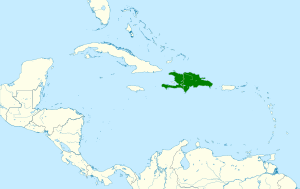Ashy-faced owl facts for kids
Quick facts for kids Ashy-faced owl |
|
|---|---|
 |
|
| Ashy-faced owl | |
| Conservation status | |
| Scientific classification | |
| Genus: |
Tyto
|
| Species: |
glaucops
|
 |
|
The ashy-faced owl (Tyto glaucops) is a special kind of owl. It belongs to the barn owl family, called Tytonidae. You can only find this owl on the Caribbean island of Hispaniola. This island is shared by two countries: Haiti and the Dominican Republic. These owls like to live in dry shrublands or forests that have been changed by people.
Contents
About the Ashy-faced Owl
The ashy-faced owl looks a lot like the American barn owl. Its face is shaped like a heart and is a grey color, like ash. The top of its head and body are yellowish-brown. They have dark grey or black spots. The owl's belly and underside are pale.
Size and Sound
Adult ashy-faced owls are about 26 to 43 centimeters (10 to 17 inches) long. They weigh between 200 and 400 grams (7 to 14 ounces). Their call sounds like a quick series of clicks. This is often followed by a wheezing sound. They can also make a loud, sharp scream.
Where Ashy-faced Owls Live
The ashy-faced owl lives only on Hispaniola. You can also find it on some smaller islands nearby. It is more common in the Dominican Republic than in Haiti. These owls usually live in forests and open woodlands. They are often seen close to towns and villages.
How Ashy-faced Owls Behave
The ashy-faced owl stays in one place. It does not migrate to other areas. It builds its nests in different spots. These include holes in trees or cracks in rocks. They also nest on rocky ledges and inside buildings. Female owls lay between three and seven eggs. This usually happens sometime between January and July.
Ashy-faced Owl's Diet and Neighbors
Like most owls, the ashy-faced owl hunts at night. It eats small animals with backbones, called vertebrates. One of its favorite foods is the Hispaniolan solenodon. This is a unique mammal found on Hispaniola.
Food Competition
The American barn owl arrived in Hispaniola around 1950. Scientists wanted to know if these two owl types competed for food. In 2010, a study was done in the Dominican Republic. Researchers looked at owl pellets. These are small balls of undigested bones, fur, and feathers that owls spit up.
The study found that both owls eat over 100 different kinds of prey. They shared 92 of these prey species. Small mammals were a big part of both diets. The American barn owl ate even more small mammals. Both owls ate a similar number of bats. However, the ashy-faced owl ate more birds. It also ate more amphibians and reptiles than the American barn owl. Scientists are still studying if the arrival of the American barn owl has harmed the native ashy-faced owl.
Ashy-faced Owl's Status
The IUCN (International Union for Conservation of Nature) keeps a Red List of Threatened Species. They list the ashy-faced owl as "Least Concern". This means it is not currently in danger of disappearing. The owl lives across a very wide area of Hispaniola. Even though it is not super common, its population seems to be steady. The ashy-faced owl does compete with the American barn owl for nesting spots and good places to live.
See also
 In Spanish: Lechuza cara ceniza para niños
In Spanish: Lechuza cara ceniza para niños


